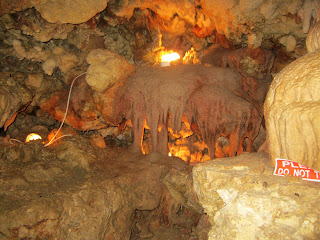Next we visited Sardinia’s top wine producer, Sella e Mosca. We have already drunk the bottle of frizzante and have a few bottles ready to chill at a future destination.
Back on the coast, just 10 km away, we visited the Nuraghe di Palmavera, a 3500 year old Bronze Age settlement. It was not as extensive as Su Nuraxhi that we had visited a few days ago but we recognized the same layout as we crawled in through the tunnels.
We drove to Porto Torres and then back to Spiaggia delle Bombarde where we enjoyed a refreshing swim. This is regarded as the best local beach with its aquamarine water, sandy beach, facilities and restaurants.
We drove back into Alghero, put our wine in the frig for later, enjoyed lunch and a rest before setting out again.
To visit Neptune’s Grotto, you can go by boat or drive and then walk down the 656 steps. Guess which we chose? The cave system is immense and we spent an hour on a tour. It was spectacular – world standard. Not the best conservation practices in place perhaps.
Back to the harbour, we walked up to the cathedral, which is very interesting as it retains strong Catalan influence.
We returned to the B & B and polished off our frizzante, Aliante Isola dei Nuraghi.
Out to dinner, followed by a stroll through the old town and the harbour front, which had a real Friday night buzz.
 |
| One of the tombs at the site. |
 |
| Looking for Robert. The remains of the central tower in the bronze Age village. Coming out of the tower. Neptune's Grotto The belltower of the duomo as we returned from the grotto |




















































